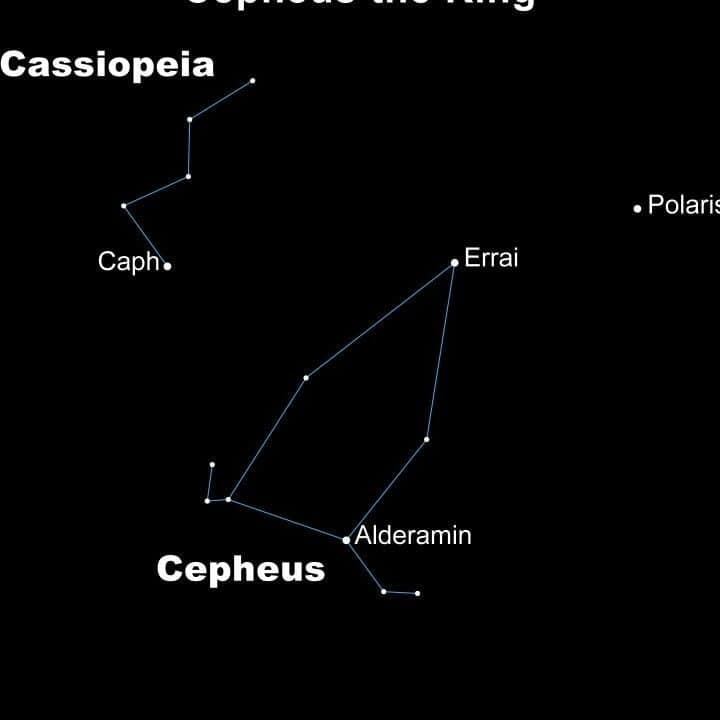
The constellation Cepheus
Cepheus, also known as Cepheus, is a constellation located in the Northern Hemisphere of the sky. Its shape resembles an irregular pentagon. The southern region of the constellation lies along the Milky Way. It covers an area of 587.8 square degrees in the celestial sphere and contains 148 stars that can be seen with the naked eye. Due to precession, the north pole of the Earth gradually moves towards Cepheus. In the year 3100, the star Alrai (γ Cep) will be in close proximity to the pole. From 5100 to 6500, the star Alfirk (β Cep) will be even closer to the pole. Finally, starting from 8300, the star Alderamin (α Cep) will take over as the polar star.
The celestial bodies
- μ Cep is famously referred to as Herschel’s garnet star due to its deep red hue. This star exhibits semi-regular variations in its luminosity, ranging from 3.4 m to 5.1 m. In terms of size, μ Cepheus is one of the largest stars visible in the night sky, boasting a radius of 11.8 astronomical units.
- VV Cepheus is an intriguing binary star system characterized by eclipses and a period of approximately 20.34 years. Its primary component is a red giant, which possesses a diameter 1200 times that of the Sun.
- HR 8164 shines with a magnitude of 5.66.
- Kruger 60 is a double star system with a combined magnitude of 10. It consists of two red dwarfs and is situated a mere 13 light-years away from Earth.
Remarkable items
- NGC 188, the star cluster, is among the Galaxy’s scattered clusters and is considered one of the oldest, being approximately 5 billion years old.
- NGC 6946, a spiral galaxy, stands out due to the discovery of 7 supernovae within its boundaries, which is more than any other galaxy.
Chronicle
This constellation has an ancient history. The Greeks credited Eudoxus with its creation, although he is likely only responsible for the first written description of the constellation. It is also included in Claudius Ptolemy’s Almagest catalog of the celestial sphere.
Cepheus, the mythical Ethiopian king, was the spouse of Cassiopeia and the father of Andromeda.
On Arabic maps, the constellation is known as Al-Multaghib and it is referred to as “fiery” or “ardent”. The hero is depicted with one foot resting on the pole and the other on the Little Bear. He is adorned with a turban and a crown on his head. In one hand, he holds his cloak, while in the other, he proudly wields his royal scepter.
Observation
Cepheus can be found positioned between Cassiopeia and the Little Bear. The α star of Cepheus lies on a direct path connecting the α and β stars of Cassiopeia, at a distance that is four times greater than the distance between these stars.
The optimal circumstances for making observations occur during the months of July-September. However, because of its significant northern declination, the constellation remains visible across Russia for the entirety of the year.
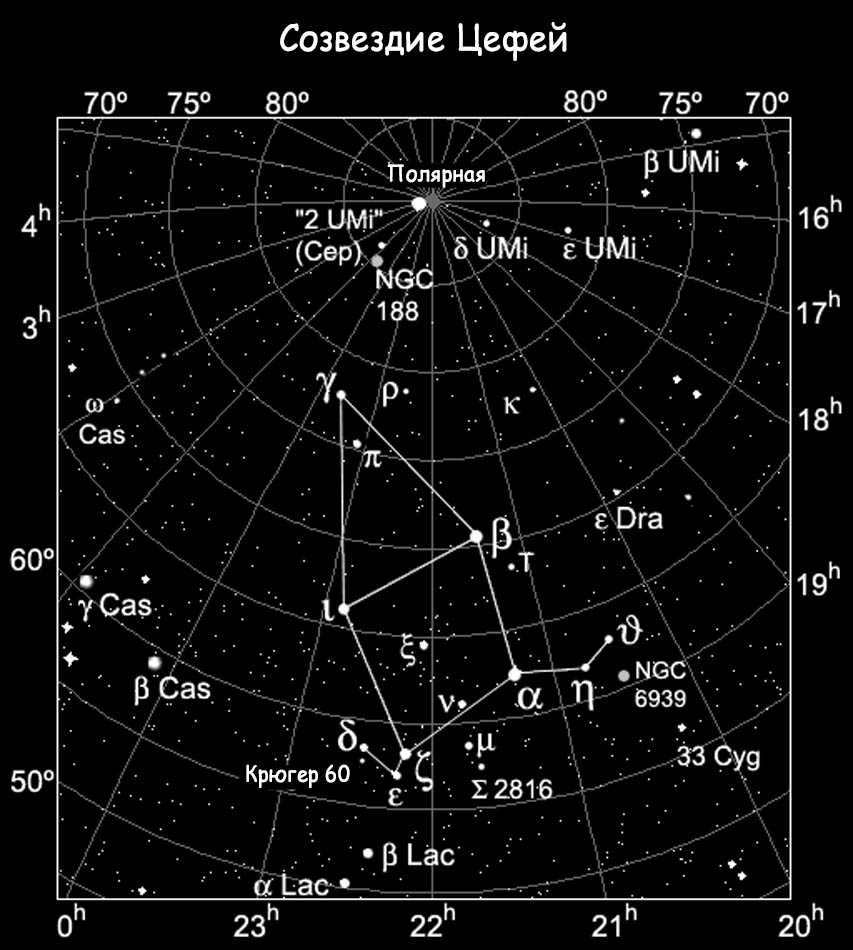
What information should individuals who are unfamiliar with this constellation acquire? Thus, the constellation Cepheus is a constellation that is situated near the pole and can be observed in the Northern Hemisphere of the celestial sphere.
An ancient ruler of the astronomical expanse
The configuration of the constellation Cepheus does not exactly resemble a regular pentagon. It becomes even simpler to envision if you sketch a house with a roof (a square and a triangle) on a sheet of paper, reminiscent of the drawings we created as children. By flipping it over, you can readily identify a comparable representation in the celestial sphere.
Where and when can you see the constellation Cepheus?
To locate the constellation Cepheus, you can reference its neighboring constellations such as Ursa Minor, Cassiopeia, Lacerta, Draco, and Cygnus if you are familiar with the night sky map. Although Cepheus lacks bright stars, with only eight of them having a magnitude greater than four, you can still observe approximately 60 stars from this constellation on a clear moonless night. The best time to observe Cepheus in the southern hemisphere is from July to September. However, since Cepheus is heavily tilted towards the north, it remains visible throughout the year in regions like Russia.
This constellation occupies a relatively small area of 588 square degrees in the celestial sphere. An intriguing fact: in the near future, the world’s north pole will shift within the constellation Cepheus. This phenomenon can be attributed to the Earth’s axis precession, which will align with the described constellation. Therefore, by the year 3100, the star gamma Cepheus (or Alrai) will assume the position near the pole. Beta Cepheus (or Alfirk) will approach the north pole between the years 5100 and 6500, and by 8300, the star Alderamin (or alpha Cepheus) will become the new polar star. Now, let’s delve into the discussion of the most fascinating stars within this constellation.
Upcoming polar star in the constellation Cepheus
Shift of the North Pole of the globe
As previously mentioned, due to the axial precession, the star alpha Cepheus is expected to become the polar star in approximately 4,000 years. This is significant because Alderamin is the most luminous star in this constellation, despite having a magnitude of only 2.45m. It can be easily observed with the naked eye, even in areas with excessive light pollution. Alderamin is located 49 light-years away from Earth. Translated from Arabic, the name of this celestial body means “right hand”.
Alpha Cepheus
When discussing the astronomical classifications of Alpha Cepheus, it is important to note that it is a typical A-class white star. Its luminosity level places it in the subgiant category. There are indications that Alderamin is undergoing a transition to become a red giant due to the depletion of its hydrogen reserves. Based on the distance between Alpha Cepheus and Earth, as well as its surface temperature of 7500 K, we can make the following assessments regarding its parameters. The star’s radius is estimated to be two and a half times that of the Sun, and its mass is 1.9 times that of the Sun. Alderamin’s total luminosity is approximately 19 times that of the Sun. Similar to other stars in its class, Alpha Cepheus is also classified as a variable star.
The original member of the Cepheid clan is Cepheus delta
Another fascinating celestial body within this particular constellation is Cepheus delta. This star is also known as Aldarif, a name derived from the Arabic word for “next”. Delta Cepheus is classified as a typical binary star system and resides approximately 891 light-years away from our vantage point. The star Aldarif played a pivotal role as the precursor to an entire lineage of pulsating variable stars known as Cepheids. The fluctuating brightness of Cepheus’ delta was first documented back in 1784 by the prodigious scientist, Goodricke.
The luminosity pattern of the star δ Cepheus
The luminosity of this star undergoes changes every 5 days and 9 hours. It is important to note that the increase in brightness happens much faster than the decrease. Aldarif has a maximum stellar magnitude of 3.5m and a minimum of 4.4m. The spectrum analysis of this celestial body has revealed some fascinating and even contradictory characteristics. During the moment of minimum luminosity, delta Cepheus exhibits the typical traits of stars belonging to the G2 spectral class (similar to the Sun), but during the moment of maximum luminosity, it transforms into a luminary of the F5 class. One might assume that Aldarif is a binary star, but its light curve differs significantly from that of spectrally double stars.
The shock wave originating from the delta Cepheus star
Scientists have made a fascinating discovery about the behavior of the star: it undergoes a unique pulsation process where it alternates between shrinking and expanding, resulting in a change in its diameter by millions of kilometers. In fact, its radius, which is approximately 40 times that of the Sun, can fluctuate to four times the size of the Sun during these pulsations. Interestingly, as the star contracts, it starts to heat up and its spectrum undergoes a transformation. Despite the reduction in its radiation surface, the star emits a much brighter light. On the other hand, during the expansion phase, Delta Cepheus exhibits the opposite behavior. These stars, similar to Aldarif, have masses ranging from 3 to 30 times that of the Sun and have mostly departed from the main sequence of stellar evolution.
Delta Cepheus B
Delta Cepheus B is the companion star of Aldarif. It has a stellar magnitude of 7.5m and is situated at a distance of twelve thousand astronomical units from the main star.
The orbital period of the companion star is around 500 years. Even with a small telescope, this star is visible in the sky.
The incredibly powerful celestial body is μ Cepheus, a star in the constellation of Cepheus
Comparison of sizes between μ Cepheus and the Sun
The following celestial object does not have a widely recognized “popular” name, but is referred to as Mu Cepheus due to its constellation membership. It is often referred to as Herschel’s Garnet Star, named after scientist William Herschel, who noted its striking color. This star is classified as a red supergiant and is one of the largest and most powerful stars in the Milky Way galaxy, with a luminosity up to 350,000 times greater than that of the Sun. Mu Cepheus belongs to the spectral class M2Ia.
Characteristics of Mu Cepheus
The star Mu Cepheus can be observed from Saturn’s rings, as shown in the Cassini image taken on July 3, 2013.
Mu Cepheus is a member of a triple star system. Besides the primary star, this system also contains two other components: mu Cepheus B, which has an apparent magnitude of 12.3m, and mu Cepheus C, with a stellar magnitude of 12.7m. It is important to note that Mu Cepheus is currently in its final stage of evolution.
The process of helium fusion has already commenced, leading to the subsequent conversion into carbon, providing undeniable evidence of its demise. It is likely to undergo a supernova explosion within the next several million years, subsequently forming a black hole from its massive core.
A giant star in the Cepheus constellation.
As you may have already noticed, the Cepheus constellation stands out for its unique collection of stars. Another notable feature of this constellation is the star VV Cepheus, which is a binary eclipsing star located just 5000 light years away from Earth. As a result, its primary component, known as A, is the third largest star in terms of radius and the second largest in terms of size in the entire Milky Way galaxy!
VV of Cepheus A
VV of Cepheus A in comparison to Jupiter’s orbit
So, VV Cepheus A is a rare red hypergiant star, categorized as an M2 spectral class. It is the second largest star in the galaxy, following the giant VY in the constellation Canis Major. With a diameter approximately 1800 times greater than that of the Sun, and a luminosity estimated to be between 275,000 and 575,000 times greater than the Sun’s, it is truly remarkable. Scientifically, it has been confirmed that component A of VV Cepheus is a variable star that pulsates with a period of 150 days. By estimating its orbital motion, we can deduce that its mass is around one hundred times that of the Sun, although considering its luminosity, we can only speculate it to be between 25-40 solar masses.
VV Cepheus B
The second part of the star in question is known as VV Cepheus B. It was discovered in 1936 that this star is not only a binary star, but also an eclipsing variable. Over the years, astronomers have observed eclipses of the B component occurring every 20 years. VV Cepheus B is a blue star and belongs to the main sequence in the B0 spectral class. It revolves around the A component in an elliptical orbit. The complete orbit takes approximately 7430 days, which is equivalent to about twenty years. The eclipse of the A component by the B component lasts for approximately 3.6 years. The diameter of VV Cepheus B is roughly 10 times larger than that of the Sun, and its luminosity is about a hundred thousand times greater. The distance between the two components of VV Cepheus varies between 17 and 34 astronomical units.
Kruger 60: A Celestial Star in the Constellation Cepheus
Comparing the Sizes of Kruger 60 A, Kruger 60 B, and Our Very Own Sun
Another captivating celestial object within the Cepheus constellation is Kruger 60, also known as DO Cepheus. This binary star system is situated approximately thirteen light years away from our Sun. Comprised of two red dwarf stars, Kruger 60 exhibits a shared center of mass around which they both orbit. The orbital period for this rotation is nearly 45 years. The larger of the two stars is designated as Kruger 60 A, while the more modest one is referred to as Kruger 60 B. Notably, Kruger 60 B is classified as a flaring star, with its flares occurring at regular 8-minute intervals. During these flares, Kruger 60 B shines twice as brightly before returning to its normal luminosity.
Photographic Image: Kruger 60 A and Kruger 60 B
The parameters of Kruger 60 are as follows: component A has a mass equivalent to 27% of the Sun’s mass and a radius that is approximately 35% of the Sun’s radius. On the other hand, component B has a mass that is 18% of the Sun’s mass and a radius that is around 24% of the Sun’s radius. The average distance separating Kruger A and Kruger B is 9.5 astronomical units, which is similar to the distance between Saturn and the Sun. Nevertheless, the orbit of Kruger 60 has some eccentricity, meaning that the mentioned distance can fluctuate between 5.5 and 13.5 astronomical units.
Other Points of Interest in Cepheus
The Scattered Cluster NGC 188
In addition to its astonishing stars, Cepheus boasts a variety of other celestial objects worth exploring. One particularly intriguing find is the scattered cluster known as NGC 188. This cluster holds a special place in the galaxy, as it is one of the oldest, with an estimated age of at least 5 billion years. Comprised of around 120 stars, NGC 188 is located a staggering six thousand light years away from Earth.
NGC 6946 is a captivating spiral galaxy with a junction. Positioned to the left and above it, you can observe a dispersed star cluster known as NGC 6939.
The NGC 6946 spiral galaxy is not only fascinating to astronomers but also to the general public. It is affectionately referred to as “Fireworks”. Situated 22 million light-years away from us, it was first identified by scientist Herschel in 1768. What sets this spiral galaxy apart is the remarkable occurrence of 9 supernovae, surpassing any other galaxy we know of!
Background
The constellation Cepheus has a rich history that is intertwined with Greek mythology. It is closely associated with the constellations Andromeda, Cassiopeia, and Perseus. According to Greek mythology, Cepheus was an Ethiopian king who was married to Cassiopeia and was the father of Andromeda. Cepheus played a crucial role in the story of Andromeda’s rescue from the monster Perseus.
Cepheus is a circumpolar constellation located in the Northern Hemisphere. It can be easily identified by its unique pentagon shape or by its resemblance to a child’s drawing of a house with a pointed roof.
Overview
Background

The representation of Cepheus in the Leiden Aratea manuscript, which includes the astronomical chapters “Apparition” (Phainomena) by Aratos de Soles (310-245 BC), dedicated to the constellation, in the Latin translation of Germanica.
This particular constellation is part of a collection of constellations that are linked to the myth of Andromeda. Cepheus was one of the 48 constellations originally defined by Ptolemy.
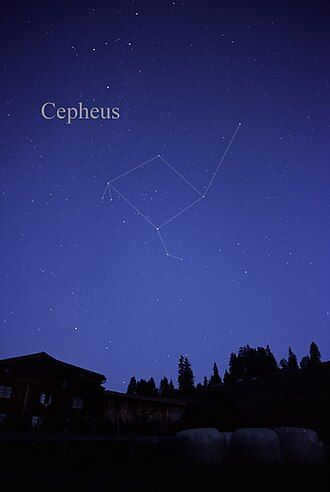
Constellation Location
Generally, the constellation Cepheus can be found just north of the Cassiopeia – α Swan (Deneb) axis, which is a significant celestial observation line that extends past Cassiopeia towards Capella and on the other side, past the Swan through the Serpentarium to Antares in Scorpius.
In the image on the left, you can see Cassiopeia, and below it is Deneb. The constellation Cepheus is located near the feet of the Dragon, which is at the top right of the picture. However, finding this constellation itself can be challenging, so it is not commonly used for direct location purposes.
Shape of the Constellation
Cepheus is a dim constellation, with its companion Cassiopeia shining much more brightly. When the visibility conditions are good (magnitude 4), we can observe the general shape of Cepheus. It appears as a rectangular figure, resembling a head with a small eye in the center. Towards the north, it is topped with a pointed hat pointing towards the star α of the Little Bear (also known as the Pole Star). On the southern side, there is an indistinct alignment that forms a mouth (belonging to Cassiopeia’s side) and a mat (opposite side).
Locating Cepheus is quite simple. One can start by identifying the “W” shape of Cassiopeia and draw a line from α Cassiopeia to β Cassiopeia. This line will lead directly to the star α in Cepheus.
The edge of the mouth, represented by the star δ Cep, lies on the Cassiopeia-Deneb trace. The alignment between δ Cep and α Cep indicates the base of the “quadrilateral” shape.
The alignment that enables us to locate the North Star from the Big Dipper is known as the tip of the hat (γ Cep). By extending the Big Dipper by approximately 25°, we can find γ Cep, which is the sole prominent star in this area. This alignment is depicted in the illustration of the Dragon, where it serves as the lower boundary.
The primary celestial bodies are.
Alderamin (α Cephei).
Alderamin (α Cephei), the most luminous star in the constellation, holds a second magnitude (2.45) but outshines all other stars within the constellation. Situated at the western base of Alderamin’s “house,” this star, whose Arabic name translates to “right hand,” is a white star twice the size of the Sun. It exhibits rapid self-rotation, spinning at a speed of approximately 250 km/s at the equator, completing one revolution in half a day.
Due to the precession of the equinoxes, Alderamin will become the closest star to the North Pole of the Earth in 5,500 years, with a deviation of less than 3°.
δ Cephei
δ Cephei serves as the archetype for the Cepheid variables and bestowed upon them their moniker. Its luminosity undergoes a consistent change from 3.5 to 4.3 over a remarkably regular time span of 5 days, 8 hours, 47 minutes, and 32 seconds.
Furthermore, δ Cephei is a supergiant star that exhibits a warm yellow-white hue. It possesses a companion star with a magnitude of 6.3, situated at a distance of 12,000 astronomical units. These two celestial bodies have been locked in mutual orbit for over half a million years.
Situated in close proximity to Zeta Cephea in the night sky, δ Cephei can be found at the lower extremity of the recognizable constellation known as the “house”.
Gamma Cephei, known as the “roof” star, is just 13 degrees away from Polaris.
μ Cephei is sometimes referred to as a garnet star because of its stunning red hue, which can only be observed through a telescope. Interestingly, it serves as the North Star for Mars, the red planet (being within 8 degrees of the north celestial pole located in Cygnus). This red supergiant is one of the largest stars visible, with a diameter of 15 astronomical units. If it were to replace the Sun, it would extend halfway between the orbits of Jupiter and Saturn.
VV Cephei is even larger than μ Cephei (though less visible to the naked eye) and would surpass the orbit of Saturn rather than the Sun. V354 Cephei and RW Cephei are also red supergiants.
Celestial entities
The constellation Cepheus houses numerous star clusters and nebulae as the Milky Way traverses it. Notable celestial objects include the Grotto Nebula, the planetary nebula NGC 40, the diffuse cluster NGC 188, whose stars have an age of approximately 6 billion years, the red nebula NGC 7023, which is illuminated by a variable star or diffuse cluster, and the nebula IC 1396, which has a shape resembling an elephant’s trunk.
Related Articles
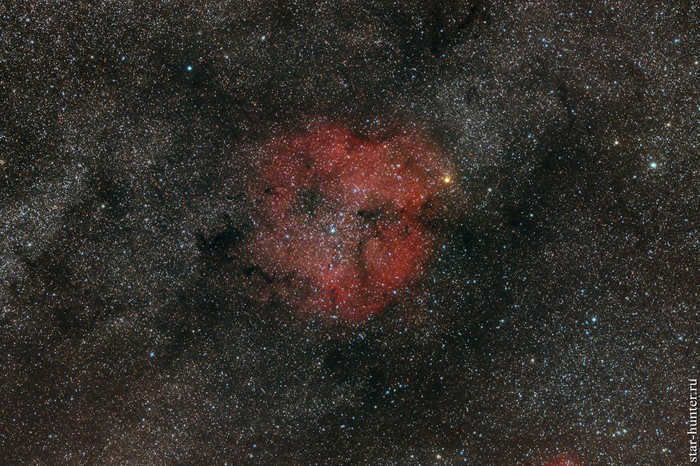
Overall, this shot is amazing as always)
Why is a shorter focal length being guided by a larger telescope with a camera that has almost half the pixel count? Two-minute exposures at that focal length should be easily captured without any guiding…. I’m also curious about how the guide is attached to the setup.)
Additionally, in full resolution, the gray rings around the larger stars are noticeable, which slightly detracts from the overall impression.
In one of your previous posts, you shared an unprocessed image of a galaxy. I would love to see the same photo of the Andromeda galaxy.
It’s incredible! Today, you have the ability to capture something of that caliber not with the Hubble telescope, but right in your own backyard. I’m curious, though, are the colors authentic or do you manipulate them in some way? When you look at the sky with your naked eye, all the stars and clusters, like the Pleiades, appear silver and the sky as a whole appears that way too. However, in this image, everything appears red. How is this possible?

Saturn, August 18, 2023, 12:01 PM.
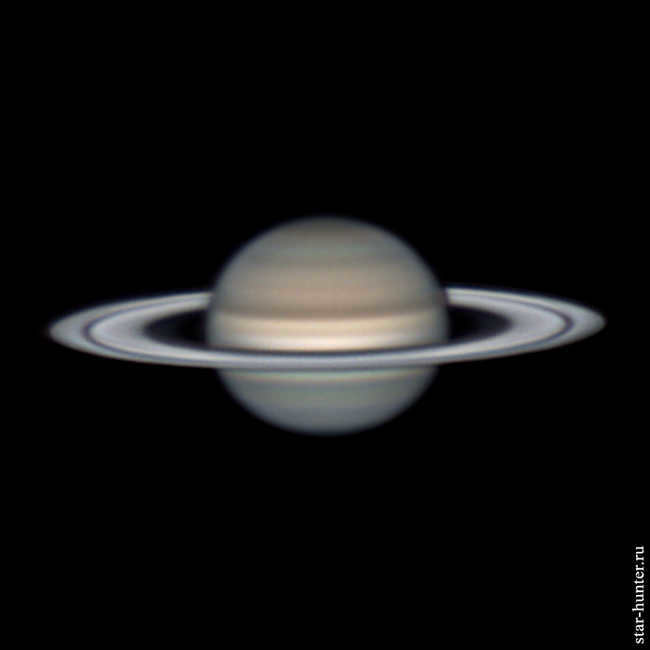

Equipment Used:
-Sky-Watcher Dobsonian 14-inch (350mm) Retractable SynScan GOTO Telescope
-NPZ PAG 3-5x Barlow Lensblock
-ZWO ADC (Atmospheric Dispersion Corrector)
-ZWO IR-Cut Light Filter
-ZWO ASI 183MC Astronomical Camera
Observatory Location: Caucasus Mountain Observatory, Moscow State University, Karachay-Cherkess Republic
Segment Extracted from the Original Video:

Video footage of the Jellyfish Nebula captured using three narrowband filters
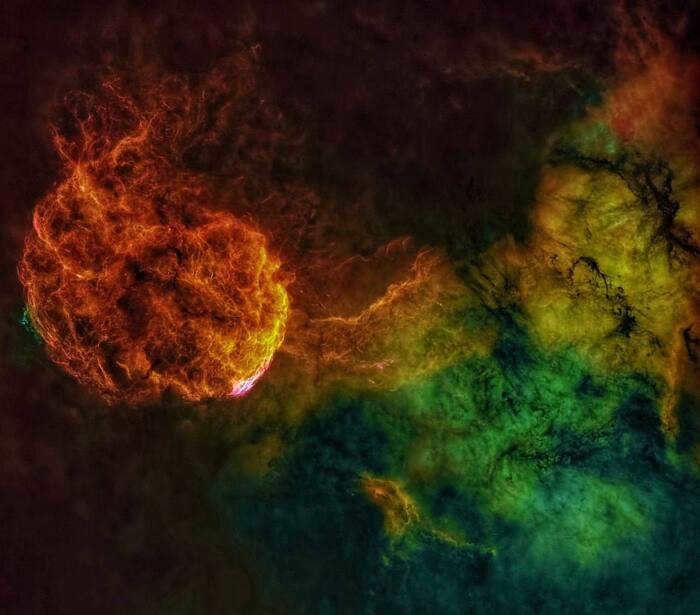
Varying Perspectives of the Milky Way

The latest comet C/2023 P1 (Nishimura)
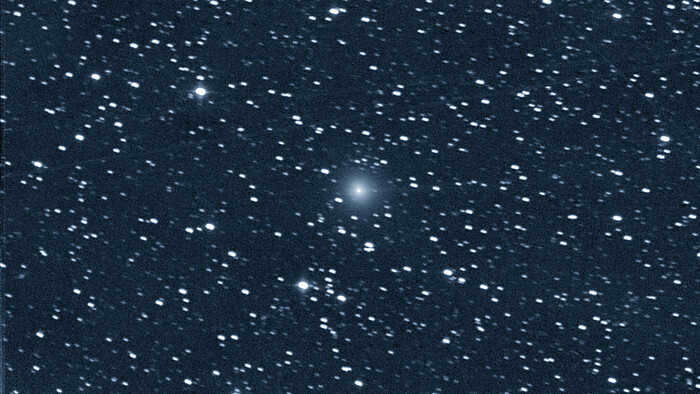
Comets are unexpected visitors. While the old ones, which have been known to us for a long time, can be quite disappointing (which is not surprising, as they tend to deplete and melt during repeated approaches to the Sun), newly discovered comets can often be bright and spectacular. However, this is not always the case.
Astronomer Hideo Nishimura discovered comet C/2023 P1 on the night of August 11-12, 2023. The comet was located in the Gemini constellation (and it is still there). It can be said that the discovery of the comet was a stroke of luck, as finding a faint nebulous object (with a magnitude of 12) in the brightening predawn sky is a great stroke of luck and a testament to the astronomer’s high level of professionalism.
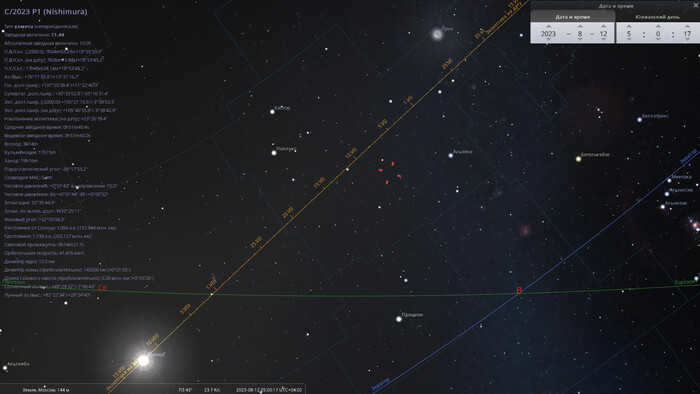
The constellation Gemini was the location of comet C/2023 P1 on the morning of August 12, 2023 (at the time of its discovery).
However, the brightness of the comet increased with each passing night. And now, after a week, it has already surpassed 10 stars in brightness. It is now visible in medium-power amateur telescopes. While the comet Nishimura can still be observed before dawn, its visibility conditions have slightly improved since its initial discovery.
What Comes Next?
On the 18th of September, 2023, the comet will reach its perihelion, the point in its orbit that is closest to the Sun, at a distance of 33 million kilometers from its glowing surface. This is approximately twice as close as Mercury. However, it’s important to note that while Mercury is a solid rock, the comet is made of ice, which will start to melt and vaporize much earlier than the perihelion. In fact, this process is already underway, and astronomers have observed a small tail, only 8-10 angular minutes in length, composed of gases and dust emitted from the comet’s heated nucleus.
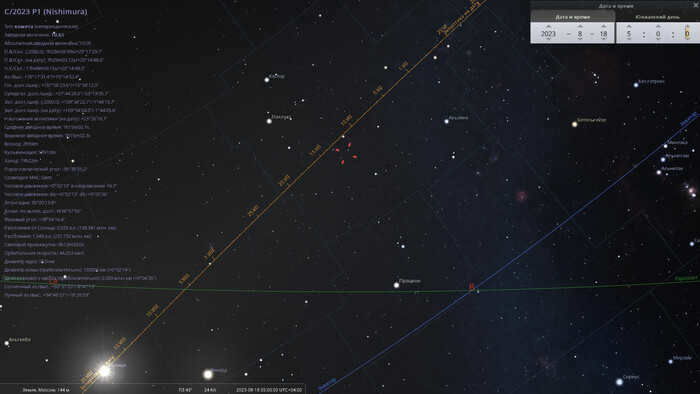
The comet C/2023 P1 will be located in the constellation Gemini on the morning of August 18, 2023.
Currently, the comet is traversing the Earth’s orbit and is positioned on the opposite side of the Sun. As a result, the distance between the Earth and the comet is significant, measuring one and a half astronomical units. However, this situation is rapidly changing.
By early September, the distance between the Earth and the comet will decrease to one astronomical unit (and the distance between the comet and the Sun will be half an astronomical unit). Although the angular distance from the Sun (elongation) will slightly decrease from 35 to 30 degrees, this inconvenience will be offset by the increasing difference in declination between the Sun and the comet. In fact, the tail of the comet will be visible directly above the Sun, allowing for excellent visibility before sunrise.
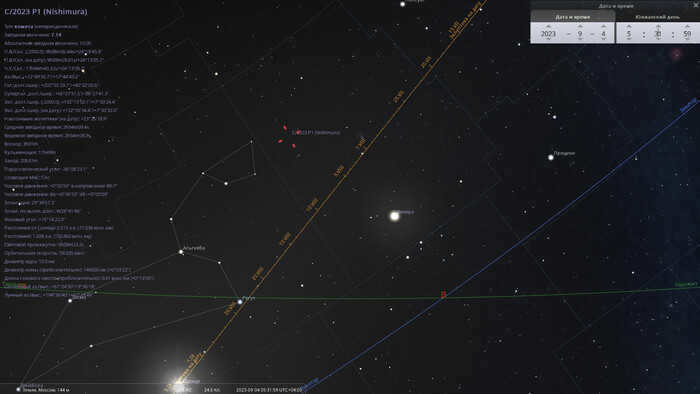

On September 4, 2023, Comet C/2023 P1 can be found in the Cancer constellation.
In the night sky, you can spot Comet C/2023 P1 Nishimura in the Cancer constellation, close to the border with Leo constellation (look for the “Lion’s Head” asterism as a useful guide). Additionally, bright Venus will also be shining nearby in the same constellation. The comet will have a magnitude of 7 on September 4, 2023, making it easy to observe with binoculars.
At dawn on September 9, 2023, the comet C/2023 P1 will be positioned 1 degree to the west of the star Adhafera (Zeta Leo), and its luminosity will reach a magnitude of 6 stars. In regions with optimal circumstances (such as mountains, deserts, or steppes), the comet will be visible to the unaided eye.
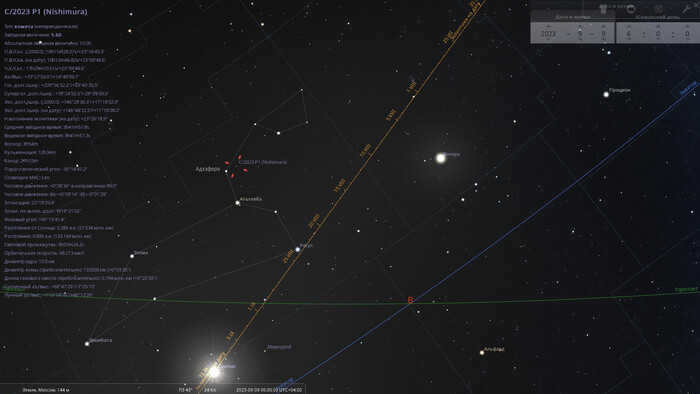
The position of comet C/2023 P1 in the constellation Leo on the morning of September 9, 2023.
Regrettably, the angular distance from the Sun will decrease to 22 degrees, however, the comet will ascend even higher above the ecliptic. Despite the limited elongation, it will remain visible for at least one and a half (and possibly up to two) hours.
In the upcoming days, the comet’s brightness will continue to increase, but its angular distance from the Sun will decrease, making observation conditions more challenging.
By the morning of September 12th, the comet’s brightness will reach a magnitude of 5 stars, while its elongation will decrease to 17 degrees. Simultaneously, the comet will remain visible above the Sun, presenting an opportunity to locate it in the early morning light near the star Zosma (Delta Leo).
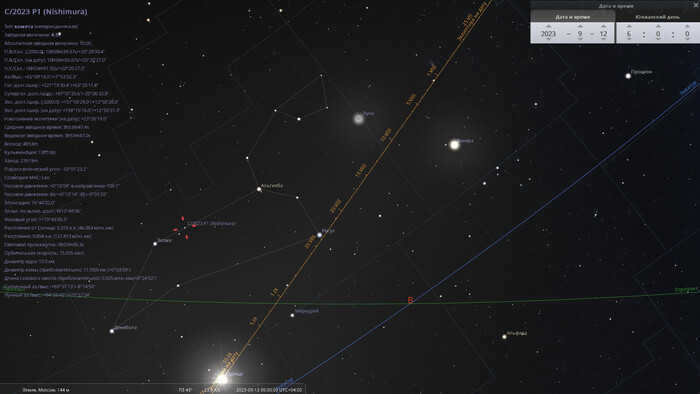
The location of the comet C/2023 P1 in the constellation Leo on September 12, 2023 morning
On September 15 morning, the comet will approach the 2nd magnitude star Denebola (Beta Leo). At the same time, the comet itself will be slightly dimmer, around 3rd magnitude. However, it will be challenging to observe both celestial objects against the bright backdrop of dawn.
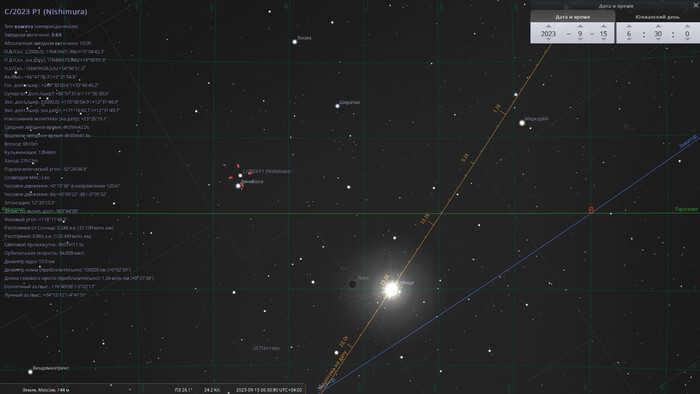
The position of comet C/2023 P1 in the constellation Leo on the morning of September 15, 2023.
During perihelion, it is expected that the comet will have a brightness of about 2nd magnitude. In the northern hemisphere, observers will be able to see the comet in the evening, shortly after dusk, as it will be located in the northern part of the Virgo constellation. However, in the southern hemisphere, it will be challenging or even impossible to observe the comet due to its declination being higher than that of the Sun.
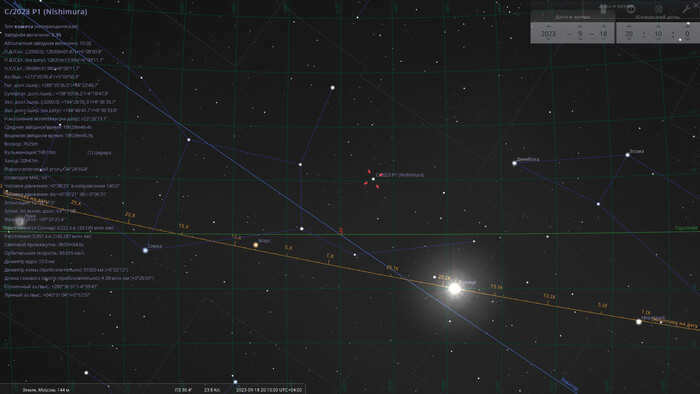
The constellation Virgo will be the location of comet C/2023 P1 on the evening of September 18, 2023, as it reaches perihelion.
As the days go by, the comet will gradually move further into the southern celestial hemisphere and will cross the equator at the same time as the Sun, just a day before the autumnal equinox on September 21, 2023. The brightness of the comet will decrease to 4.5m.
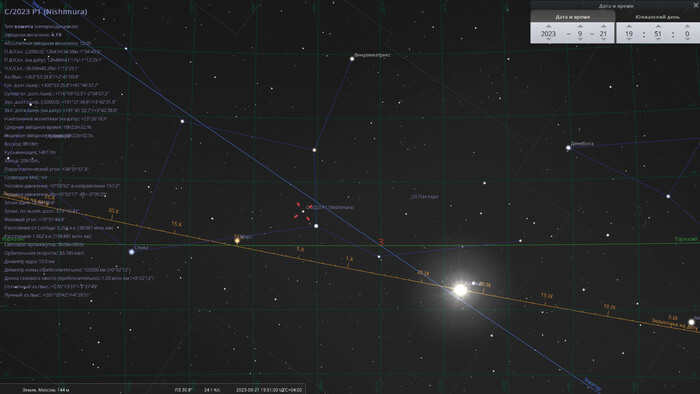
On September 21, 2023, the comet C/2023 P1 can be found in the constellation Virgo during the evening hours.
By October 1, the comet C/2023 P1 Nishimura will be visible in the evening, approximately 40 minutes after sunset, at the border of the Virgo and Raven constellations. However, to observe it, one would have to be located in Australia or the mid-latitudes of South America, or perhaps at the southern tip of Africa. The comet’s brightness will be around 7.5m, so it may not be worth purchasing tickets solely for this purpose.
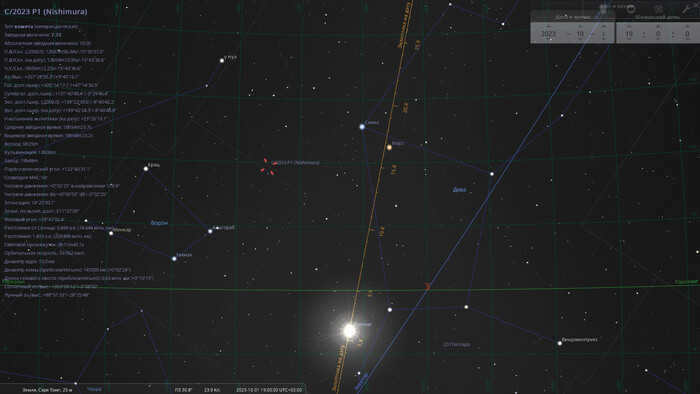
The position of comet C/2023 P1 on the evening of October 1, 2023 at the boundary of the constellations Virgo and Raven (for an observer located in Cape Town, South Africa).
By the middle of October, the comet will continue its journey southward, entering the tail end of the Hydra constellation. Its brightness will decrease to the 10th magnitude, making it difficult to observe, even in the southern hemisphere. In fact, at this point, the comet will no longer be visible to astronomy enthusiasts around the world.
When will the comet come back?
Not during our watch. Currently, the approximate orbital elements have been determined. This level of accuracy is sufficient to calculate the comet’s position in the sky for the upcoming few months. However, the exact period of its orbit remains unknown. Despite being classified as a long-period comet, its orbit’s eccentricity is considered to be one, meaning it is close to being parabolic or possibly even is. Therefore, its return to the Sun could occur in a million years or potentially never.
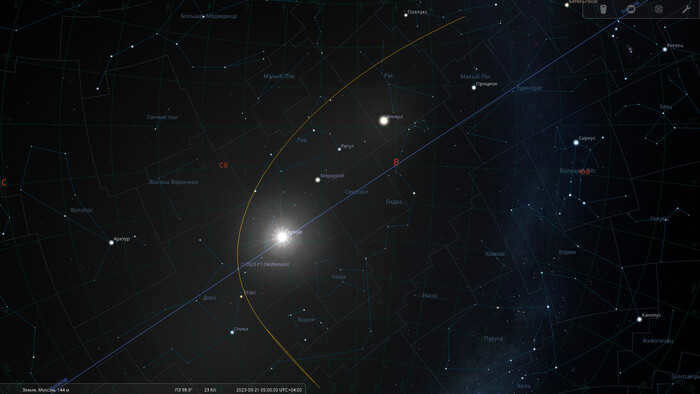
The path of comet C/2023 P1 Nishimura between August 12 and November 1, 2023
All the charts were created using the Stellarium software

The Milky Way
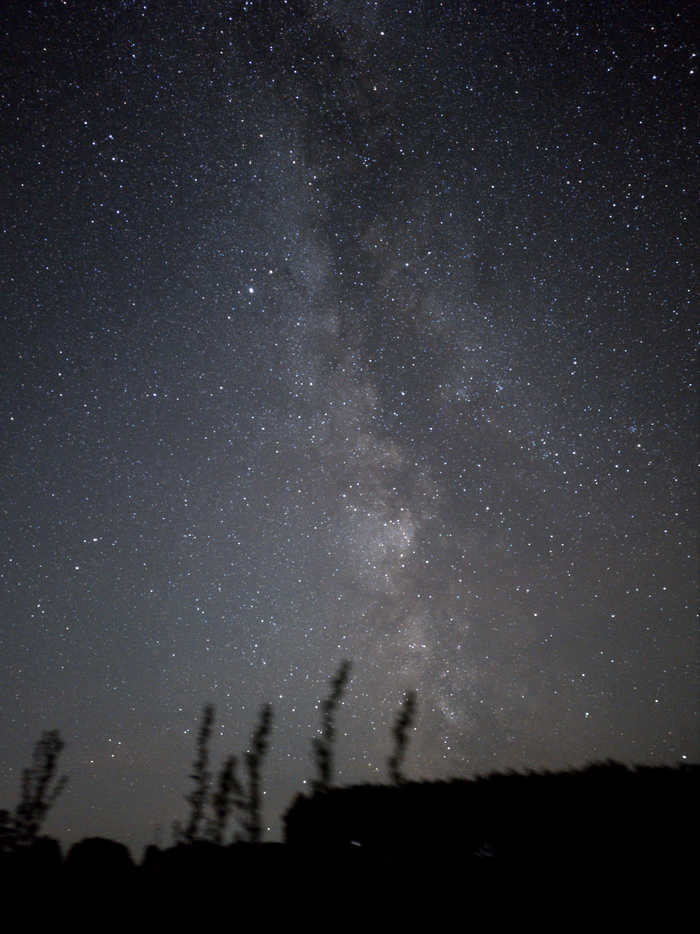
There are 10 amazing photos taken with a shutter speed of 15 seconds and ISO 3200 using a Samsung s20fe in the Southern Urals’ green zone.
Discover the most alluring properties in our solar system
It is common knowledge that the Soviet Union launched the first artificial satellite in 1957. Over the years, various space agencies, private companies, and research institutes have expanded their presence in the solar system. The extent of their conquests is too vast to enumerate. While it may appear that there is ample space for all, certain “real estate” objects hold a greater allure than others. These coveted locations include the Lagrange points, which have captured the attention of all interested parties. Named after an 18th-century mathematician who discovered them, these points offer valuable stability in the midst of our ever-changing and turbulent cosmos.
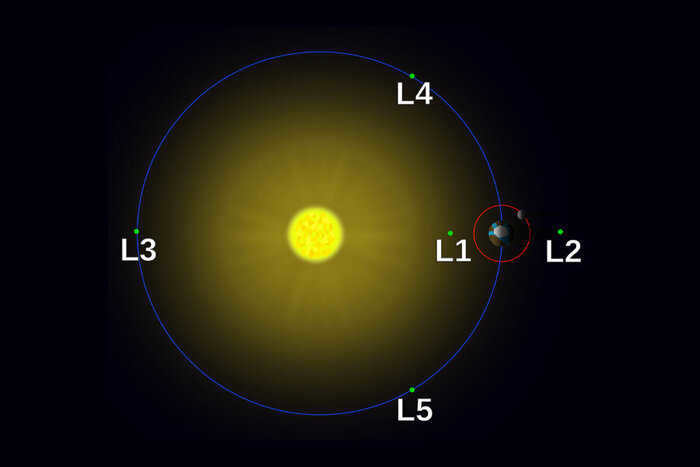
Every celestial object exerts gravitational influence on each other. This effect is particularly pronounced on nearby objects. In these systems, other forces also come into play, collectively determining the shape of the orbits of the “participants of motion”. At the Lagrangian points, these forces are perfectly balanced. Therefore, if a relatively small object is placed there, it will remain at a fixed distance from the bodies that create these stable zones. These regions are metaphorically referred to as cosmic parking lots: once something is in them, the need to expend energy to stay there practically disappears. Overall, it is an optimal location for any man-made object intended for an extended period of time in outer space.
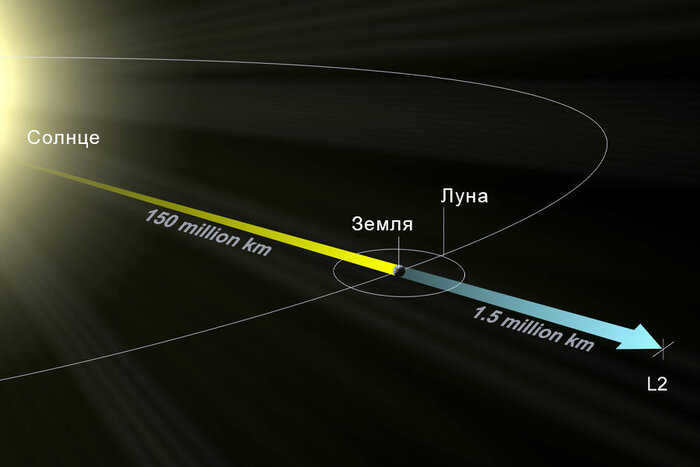
The issue of what can be placed in a specific Lagrangian point is quite intriguing in this context. Let’s examine those formed by the gravitational interaction between the Sun and the Earth. L1 is situated around 1.5 million kilometers from our planet, between these two celestial entities. Because the line of sight to the star is never obstructed, it serves as an optimal location for observing the Sun.
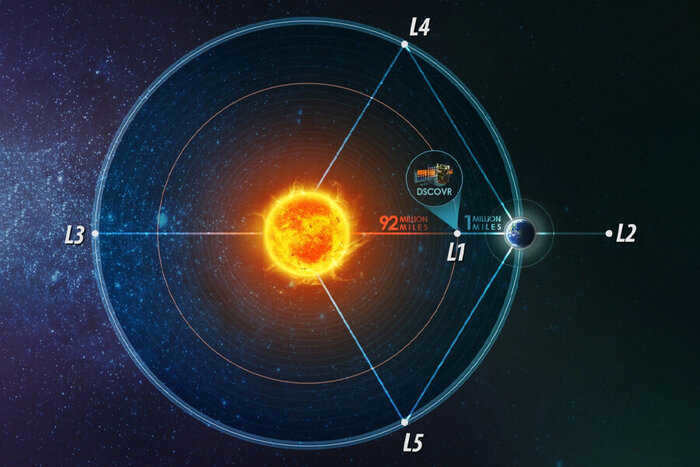
The Deep Space Climate Observatory is an American spacecraft situated at Lagrangian point 1, dedicated to observing the Sun and Earth
L2, located on the far side of the Earth at an equal distance, provides a secure shield from sunlight and offers exceptional opportunities for space observation. In 2022, the long-awaited launch of the James Webb telescope took place, commencing its operations at this unique location after two decades of anticipation by astronomers.
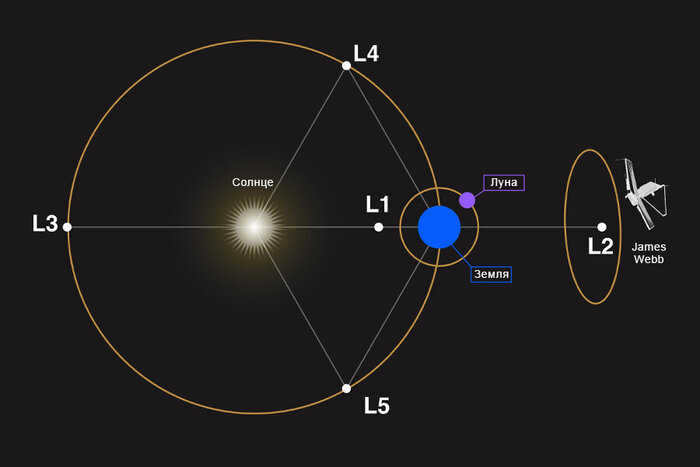
L3 is located in the most enigmatic region, precisely opposite to the Sun on the Earth’s orbit. It holds the distinction of being the sole point in the entire cosmos that is completely inaccessible from the surface of any planet, even in theory. Consequently, it has become a popular source of inspiration for science fiction authors, although scientists have little practical interest in it.
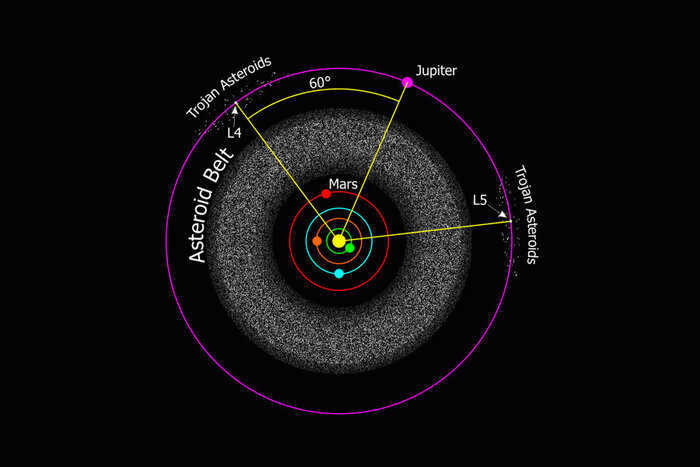
Each Lagrangian point within the solar system possesses its own distinctive characteristics. Some of these points have the potential to serve as sources for gathering construction materials, similar to drifting asteroids. Others could be designated as refueling stations to provide fuel for spacecraft embarking on deep space voyages. It is even conceivable that human colonies might be established in these locations, effectively hanging suspended in space. Naturally, this is a concept that pertains to the distant future, one that we may not witness firsthand given the current state of affairs on Earth. Nonetheless, it is always worthwhile to indulge in dreams, wouldn’t you agree?
Thank you for your kind attention! If you found this article enjoyable, please consider showing your support with a “thumbs up” or by subscribing to this channel. We would also like to take this opportunity to inform you that we maintain our very own Telegram channel, where we regularly share fascinating posts pertaining to space and astronomy.

